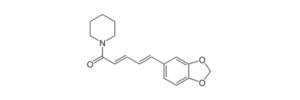-

Piperine: Health Benefits, Side Effects, and Source
Continue ReadingWhat is Piperine?
We can stay strong, healthy and active if we intake nutritious food supplements and also by following a healthy life style. Many of the vital compound which are needed for our body to keep it disease resistant and in improving our cardio vascular systems are available in our day-to-day substances.
Piperine is one such compound which is normally found in pepper, it is one of the bio active compound which imparts pungency while tasting. This is one of the naturally occurring alkaloid substance having numerous health benefits including those of aiding in therapeutic properties.
However, its biological properties are considered as the less reactive as it is easily soluble in aqueous environments. However, we know that herbs and spices have their standing long history in its culinary and the medicinal preparations due to their delightful flavour and various health benefits associated with them.
They play a very important role in preparations of the numerous medicines which are being widely used in pharmaceuticals.
Among all the spices and herbs, Pepper has its own crown and stands in a unique position by serving as a medicine and in many of the antioxidant activities.
Black Pepper is also known as “King of all spices”. It also considered as one of the most vital and the extensively used spices all over the world.
It is the only spice which is served invariably at the dinning as it is inevitable for preparing foods. Pepper has been used from past till now in various purposes.
Importance of Piperine
The value of the pepper is purely designated for its pungency and its flavour, which is attributed for the presence of a naturally occurring alkaloid substance known as Piperin, along with the volatile essential oils.
The volatile oils, comprises of about 0.4 to 0.7 percentage, which is necessary for its aroma. Even though piperine is found in abundant, these aromatic compounds play a vital and a significant role in bringing the flavour to this spice.
On the other hand, the amount of piperine in the spice varies depending on the piperaceae family, which constitutes about 2 to 7.4 percent in black and white pepper.
Piperin I found most abundantly only in the pepper than any other spices. It was first extracted from the peper by the scientist named Hans Christian Orsted in the year 1819. It was found to be in yellow crystalline compound having a melting point of about 128 to 130 degree Celsius.
Later the chemical structure of piperine was identified and it is named as piperoylpiperidine. Generally, piperin is considered as a very weak base, which on acting in the hydrolysis of acid and alkaline decomposes readily and results in a volatile basic piperine. This volatile piperine also be said as Piperidine.
In ancient times black pepper was used as a natural source of medicine in Chinese and Indian medicines, for treating the alleviatinone of pain, rheumatism, chills, fevers etc.
Black pepper is also taken in the form of tea for relieving from headaches, sored throat, and it also helps in poor digestion and also in enhancing the blood circulations by increasing the flow of saliva and by increasing the appetite. Recent studies also shows that piperine contains a chemo preventive and the antioxidant activities, and also in acting as an immunomodulatory, anticarcinogenic, stimulatory, anti-inflammatory and the hepatoprotective and the antiulcer activities.
Piperine also paves a way in enhancing the bioavailability and the bio transformative effects which helps I differentiating the drugs like rifampicin, tetracycline, sulfadiazine and phenytoin which increases their absorption by slowing the process of metabolism of the drug.
Piperin generally shows a protective effect against the radiations, so it is applied to the cancer patients before undergoing the treatment of radiotherapy.
Piperine Health Benefits
1. High in Antioxidants
Free radicals are the unstable molecules which has the ability to damage our cells, in some cases free radicals are created naturally at the time of exercise and during digestion. Excess of free radicals leads to major health problems like premature aging, heart disease and some kind of cancer, Black pepper is one of the rich sources of plant containing piperine containing the vital antioxidant properties.
2. Anti-inflammatory Properties
Chronic inflammations are one of serious factors, which causes many conditions like arthritis, heart diseases, diabetes and in causing cancer. Many of the active compounds found in the piperine helps to fight against the inflammation.
3. Benefiting the Brain
Piperine also plays a great role in improving the function of the brain. Many of the potential benefits can be obtained from the piperin which helps in healing the Alzheimer’s and the Parkinson’s disease.
4. Blood Sugar Control
Piperine present in black pepper helps us to reducing the blood sugar levels and also shows a significant improvement in inducing the sensitivity of the insulin.
5. Lowering Cholesterol Levels
It is well known that high cholesterol levels cause a higher risk of heart diseases. Piperine found in black pepper helps in decreasing the high cholesterol levels and reducing the bad cholesterol levels and helps in preventing the risks of heart diseases.
6. Cancer-Fighting Properties
Piperine also plays an important role in enhancing the efficiency of traditional treatments that are being followed for treating the triple-negative breast cancer, which is one of the most aggressive type of cancer.
Piperine Citations
Share
Similar Post:
-

Pterostilbene: Health Benefits, Side Effects, and Source
Continue ReadingPterostilbene Introduction
Pterostilbene is one of the naturally derived compounds, which is most commonly found in blueberries and Pterocarpus marsupium heartwood. The consumption of the pterostilbene varies accordingly depending upon the dietary fruit intake, which has been estimated depending upon the weight of the blueberries and the type of berry that is ingested.
Pterostilbene is a group of naturally occurring polyphenol, which is one of the molecular substances occurring in plants. Pterostilbene is one of the group of compounds and the main antioxidant component of blueberries.
Especially in some species of plants, it serves as a defensive antimicrobial agent, and it also plays an important role in antioxidative role. This compound was first observed in 1977, by Lang cake and Pryce which is studies for its important antioxidant properties and also provides significant health benefits.
Pterostilbene is one of the chemically related to the compound known as resveratrol, which is another popular dietary supplement, Recent studies also suggests that this is also beneficial in providing more health benefits. In the other form it also acts a better resveratrol.
What is Pterostilbene?
It is one of the natural compounds, which can be found primarily in blueberries, Pterocarpus marsupium heartwood, this compound varies accordingly depending upon on the type of berry ingested.
Pterostilbene have numerous preventives and the therapeutic properties in a vast range of human diseases which involves neurological, cardiovascular, metabolic and the hematologic disorders.
Pterostilbene helps in treating the various kind of human diseases with its anti-oxidant, anti- inflammatory and anticarcinogenic characteristics.
Pterostilbene is one of the natural compounds that is found naturally in the blueberries. It has its chemical formula similar to those od resveratrol, which is found in the form of a dietary supplement.
Pterostilbene plays a vital role in reducing the inflammations and in offering other antioxidant benefits. Due to improper research in this field, its safety and its benefits are unknown for a longer time of period.
Pterostilbene is also used in the form of alternative medicines for treating the disorders and disabilities like Alzheimer’s disease, atherosclerosis, diabetes, high cholesterol, high blood pressure and in acting against the insulin resistance.
Physiology of Pterostilbene
Pterostilbene is one of the polyphenol compounds, which is one of the complex compounds found in plants, especially in nuts and in blueberries. Blueberries are usually rich in pterostilbene sources.
Pterostilbene is also found in grapes but not as rich in blue berries. Pterostilbene is one the polyphenol compound, in which phenol refers to a specific chemical compound having its structure in such a way that hydroxy group is linked to a benzene ring, where as poly refers to the molecules that contains more than one structure.
Hence, pterostilbene plays an important role in helping the plants to fight against pathogens. It also plays a vital role in acting as an antioxidant in humans, Scientists made an effort to realize the effort of phenol and its awareness only in early 19th century by a great researcher Joseph Lister, who was one of the great and the pioneer worker in the field of antiseptic surgery, and he also reported the disinfectant properties of phenol in the year 1867 by using the term polyphenol.
Pterostilbene Health Benefits
i. Breast Cancer
Many of the factors like poor nutrition and obesity leads to favorable factors for causing breast cancer. Several studies suggests that extracts from the blueberries, which contains pterostilbene inhibits the in vivo and the breast cancer.
Using pterostilbene for treating the cancer cells in the breast, helps in altering the cellular oxidative activities, which plays an important role in mediating the pterostilbene cell death.
ii. Cardiovascular Diseases
Cardiovascular diseases now a days leads to the increased rate of mortality rate, which is also due to the risk factors like smoking, adapting sedentary lifestyles and in lowering the intake of nutritious foods. Pterostilbene plays a role decreasing the risk of these conditions.
Pterostilbene shows a promising care against the diseases like atherosclerosis, which results in hardening of the arteries. Pterostilbene also has a capability to protect it against oxidative stress which is a destructive biological process that plays a key role in developing the heart diseases.
iii. Alzheimer’s Disease
Pterostilbene also plays a role in protecting the body against Alzheimer’s diseases and their age-related problems like cognitive delay, Recent studies have revealed that pterostilbene plays an important role in preserving the function of the cognitive, by reducing the inflammation in the particular part.
iv. Cancer
Various researches and studies suggest that pterostilbene protects and aids in preventing and treating cancers by acting as an anti-cancer agent. Pterostilbene also has the ability to hinder the growth of the cancer cells by inducing apoptosis, which is known as the programmed cell death, that is essential for declining the proliferation of cancer cells in our body. It is generally said that on consuming blue berries on a regular basis it helps us to enhance our health.
Pterostilbene Citations
Share
Similar Post:
-

Zeaxanthin: Health Benefits, Side Effects, and Source
Continue ReadingWhat is Zeaxanthin?
Zeaxanthin is one of the carotenoid compounds which plays a significant role in protecting the eyes from the various harmful effects of oxidation and also in treating the light induced damages.
Zeaxanthin is one of the yellow color compounds, which is found in the center of the macula. It can also be found in high levels in the dark green vegetables and also in fruits like organic and yellow fruits and also in yolk of the eggs.
Zeaxanthin is a kind of pigment which results in paprika, corn and saffron Zeaxanthin is commonly associated with the similar compounds like lutein. Both supplements are carotenoids which is associating in treating the health of the eyes, it is found in high levels in many of the vegetables and fruits.
Zeaxanthin Health Benefits
Zeaxanthin is also known as eye vitamin, once it is taken by our body, it is directly drawn into the eyes. It goes in way first into the lens, then to the mula, fovea, which is a center spot of retina.
Zeaxanthin helps us to build a yellow-colored pigmented compound, which shields the eye cells against the harmful effects that are caused due to certain sources of light, including the light from the sun.
Zeaxanthin helps in protecting the eyes from various harmful free radicals which forms a over time after the oxidation process, few dietary sources of zeaxanthin has been studied and protective factors in the age-related factors like macular degeneration.
Macular degeneration leads to blindness in most of the people who are above 65 years of age. In some cases, macular complication affects the younger people.
Zeaxanthin on acting along with lutein acts as a dietary carotenoid which get accumulated in the retina of the eye, particularly in the region of macula. As both the substances are found in large amounts of the macula, which are also known as macular pigments.
Zeaxanthin and lutein also helps in benefiting the body such as
Age related macular degeneration: Lutein and Zeaxanthin helps us to protect the eyes against the macular degenerations, which on later periods if left untreated leads to blindness.
Cataract: A cataract is condition which can be defined as the clouding of the lens in the eyes. Zeaxanthin and lutein consumption also helps us to slow down the process of forming the cataracts.
Uveitis: Uveitis is the inflammation or the swelling of the uvea in the eyes. Uvea is generally located in the center of the eye, it is found between the sclera and the retina, which is responsible for supplying blood to the retina. Zeaxanthin and lutein also play an important role in reducing the inflammatory processes.
Diabetic retinopathy: It is one of the complication factors of retina, which results in damaging the blood vessels that is present in retina of the eyes. On supplementing with zeaxanthin and lutein, it reduces the oxidation processors which damages the eyes.
Other Benefits: Lutein and zeaxanthin are the only dietary carotenoids, which accumulates in the retina, especially in the macula region, that is situated at the back of our eyes. As these are found in concentrated amounts in the macula, there are often referred to as macular pigments.
The macula plays an important role in vision. Lutein and zeaxanthin work as an important antioxidant by protecting the eyes against harmful free radicals.
On removing these antioxidants, it leads to damaging of the health of the eyes. Lutein also acts as a natural sun block, which absorbs the excess light energy, and especially to protect it from harmful blue light rations.
On recent years it is also suggested that zeaxanthin has a various benefit in protecting the inflammations in the skin that are caused by UVB-induced radiations.
Zeaxanthin Side Effect
Till now there is no side effects or the negative reviews being reported on zeaxanthin. On the other hand, some of the negative interactions are found on taking it with other drugs. Even though it is harmless, a person having a fair skin complexion develops a yellow coloration of the skin if the intake of zeaxanthin extends greater than the maximum rate.
It has also been found that zeaxanthin has a great role in protecting the skin cells from the premature aging and also in protecting it against ultra violet induced tumors. Zeaxanthin is responsible for most of the eye related problems.
Zeaxanthin Source
Zeaxanthin is found abundantly in the green plants and in leaves. Within the plants, it also modulates the light energy by keeping the chlorophyll at the needed amount during the process of photosynthesis.
Zeaxanthin and lutein play a vital role in giving bright colors to many of the fruits and vegetables, it is also present in more higher amounts in the green spinaches and in leafy vegetables.
The chlorophyll that is found in the dark and green vegetables including spinaches, has the capability to masks the lutein and the zeaxanthin pigments, that’s why the vegetables and leaves are green in color.
Zeaxanthin Citations
- Role of lutein and zeaxanthin in visual and cognitive function throughout the lifespan. Nutr Rev . 2014 Sep;72(9):605-12.
- Lutein and Zeaxanthin-Food Sources, Bioavailability and Dietary Variety in Age-Related Macular Degeneration Protection. Nutrients . 2017 Feb 9;9(2):120.
- Lutein and Zeaxanthin Isomers in Eye Health and Disease. Annu Rev Nutr . 2016 Jul 17;36:571-602.
Share
Similar Post:
-

Berberine: Health Benefits, Side Effects, and Uses
Continue ReadingWhat is Berberine?
Berberine is one of the chemical compounds, which is found in several plants including those of European barberry, goldenseal, goldthreads, Oregon grape, greater celamdine, tree turmeric, phellodendron.
Berberine has medical properties including those of controlling the diabetes, high cholesterol levels, and also in controlling high blood pressure. It is also used in curing the burns, canker sores, liver diseases and also in maintaining many other conditions.
Berberine is one of the natural compounds, which is most effective in treating many abnormal diseases in our body. It has a high amount of impressive health benefits which has the capability to affect our body up to a molecular level.
Berberine also works in lowering the blood sugar level, and aiding in weight loss and also in improving the health of vascular systems.
Berberine Source
Berberine is one of the most significant bioactive compounds which is extracted from different types of plants including some species of shrubs which are known as Berberis. Technically, berberine also belongs to the class go the alkaline compounds, which has its characteristic yellow color which can also be used in the form of dye.
It has also been found that berberine has been used traditionally in the cheese medicines, to treat the various kinds of ailments. In recent times, modern science has also confirmed that berberine has impressive benefits for curing different type of health issues.
Physiology of Berberine
It has also been tested in different types of studies, and also concluded that it has many powerful effects on dealing with many biological irregularities. When we consume berberine by food supplements, after the completion of the digestion process, ingested berberine is taken by the body, through the process of absorption and it is transported via bloodstream to all the cells of the body, after passing to the cells, via blood, berberine starts to bind up with the molecular targets and changes their function and helps in curing the mechanisms if it has any defects.
Simply, Berberine works in the same way how pharmaceutical drugs works in treating the ailments. One of the important actions of the berberine activation is due to presence of the enzyme named AMP-activated protein kinase, which is present inside the cells.
This enzyme can also be sometimes referred to as Metabolic master switch. This enzyme can also be found in cells of various organs in our body, including those of brain, muscle, kidney, liver and heart.
This enzyme also plays a vital role in regulating the metabolism of the body cells. Berberine also plays a role in affecting the other molecules that are found inside our cells, which participates in turning on and off the genes.
Berberine Benefits
Berberine acts as an effective antimicrobial agent, which helps us to inhibit the growth of the species of bacteria like Staphylococcus aureus. As Staphylococcus aureus has the ability to cause many of the health defects like pneumonia, sepsis, meningitis and also a wide variety of skin infections.
It has also been proved that Berberine has the ability to damage the DNA and the protein so the several species of bacteria. Berberine also aids in treating many of the inflammation processes and in treating many of the health factors like heart diseases and diabetes.
Some researchers also suggests that berberine has an anti-inflammatory property, which helps us to treat the diseases like diabetes and other inflammation related conditions.
Berberine plays an effective role in lowering the blood level in the blood and also in controlling the blood pressures. Berberine acts as a promising factor in treating the diabetes, especially for the people who are unaware or not in a condition to take the pharmaceutical drugs in case of heart or liver abnormalities.
Berberine also worked in changing the ailments caused by lifestyle factors like blood glucose level, cholesterols, etc. High levels of lipoprotein, triglycerides, cholesterols, etc. plays a significant role in increasing the risk of stroke and other cardio vascular diseases.
Berberine also helps in lowering the LDL cholesterol levels in the blood, along with human, animals also indicate the cholesterol lowering effects in the blood.
Berberine works equal to those drugs which aids in reducing the high cholesterol levels in the blood. We all know that high blood pressure is one of the major causes for heart attacks and other cardiovascular diseases.
Berberine acts as a significant agent in lowering the blood pressure and also in reducing the severity of the cases with high risk of heart diseases.
The common symptom for having type 2 diabetes is obesity, having heart sleazes and increased cholesterol and blood sugar levels, People who are suffering from the obesity are insisted to take berberine of about 750 grams in twice a day for about 3 months, which shows efficient positive results.
Berberine also plays a role in treating the Polycystic ovary syndrome, which is a condition occurring mostly in females, as they have a high number of male hormones.
This condition is often referred to as metabolic imbalances that leads to infertility and several mensural problems. Metformin is a drug used for treating this condition.
Berberine also has the same characteristics as of metformin and aids in treating this syndrome. Berberine also plays a vital role in fighting against the cancer-causing cells.
Berberine Citations
- Berberine and barberry (Berberis vulgaris): A clinical review. Phytother Res . 2019 Mar;33(3):504-523.
- Berberine, an epiphany against cancer. Molecules . 2014 Aug 15;19(8):12349-67.
- The metabolism of berberine and its contribution to the pharmacological effects. Drug Metab Rev . 2017 May;49(2):139-157.
Share
Similar Post:
-

Glutathione: Source, Benefits, and Side Effects
Continue ReadingGlutathione Introduction
Glutathione is generally known as GSH, this molecule is naturally found in our body. It is usually performed by the nerve cells (neurons) in the central nervous system and in the liver. Glutathione is a complex molecule made up of three amino acids, namely L-cysteine, Glycine and L-glutamate. Clinically it has also been said that glutathione supplements help us to treat and prevent the various defects in our body.
What is Glutathione?
In order to maintain a stable health conditions, it is important is take note that there should a proper balance between antioxidants and the free radicals, Free radicals are one of the types of oxygen which contains the molecules in the body.
If this balance is not maintained, then there exists a lot of free radicals in the body which causes the oxidative cell damage. Glutathione is an antioxidant which helps is to keep the necessary balance in our system.
Apart from acting as an antioxidant, Glutathione also plays an important part in performing many activities like metabolizing the toxic and the cancer-causing substances in our body, it also helps in repairing the DNA and natural creation of the DNA.
It also plays an important role in synthesizing the proteins and the prostaglandin, and also in activating the enzymes in the body. Glutathione also helps us in breaking the nutrients, and in regulating the important body process by activating the immune response.
Role of Glutathione in Cellular Physiology
Glutathione is one of the compounds of the amino acid which is naturally present in all the cells in the body. Glutathione acts as an antioxidant which helps in preventing and delaying the damages in the cell, and also in detoxifying the chemicals that are present in the liver.
According to recent studies it is also proven that glutathione also plays an important role in improving the immune system and also in regulating the cell growth and in regularizing the death of the cell.
Glutathione Source
Glutathione is usually known as building blocks it is usually found in the meat and in other diary products and in many vegetables. New York research suggests that, to increase the level of glutathione in our body, we can opt for the food which is rich in precursor nutrients thus helping us to form a sulfur amino acid in our body.
Generally, Brussel sprouts, onions, broccoli, cauli flower are considered as sulfur rich foods which is needed for our body in maintaining its proper functions. Glutathione is also present in potatoes, pepper, etc. Glutathione is also readily supplied commercially, it also now a days purchased in pharmacies or through online.
Glutathione is also found in natural food and it is also supplemented with personal care products. The oral glutathione supplements while digesting turns into three peptides in the form of cysteine, glycine and the glutamic acid, which brings more benefits to our body.
Glutathione Metabolism
Glutathione is a tripeptide molecule made up of three amino acids namely cysteine, glycine and the glutamic acid which is generally found in five higher levels in about five millimolar concentrations in almost all the cells.
It consists the same concentration as of glucose, cholesterol and potassium. Considering the high level of the metabolic activity that is needed for producing glutathione. Glutathione usually exists in two states as reduced GSH and the oxidized GSSG.
Oxidized glutathione is reduced into two glutathione’s which are bound together at the sulfur atoms. The redox status of the cell is usually determined by the ratio of GSH and GSSG. In some cases, glutathione is also recognized as thio buffer which maintains the sulfhydryl groups present in many of the proteins in their reduced form.
On the other hand, Glutathione is produced extensively in the cytosol and is actively pumped in to the mitochondria. Glutathione is being made available in the cells in 3 ways such as De novo synthesis, Regeneration of the oxidized GSSG and in recycling of cysteine.
Glutathione Benefits
The nerve damages that are caused by the drug cisplatin, can be cured by administrating the glutathione intravenously, which helps to prevent the nerve damages and the other toxicities from the cancer drug cisplatin.
It also plays an important role in making DNA, which is the building blocks of the proteins and the cells.
Glutathione helps in supporting the immune system and its functions.]
Forming sperm cells.
It also helps in breaking down some of the free radicals.
It also helps us to cure various health problems like hardened arteries which is also known as atherosclerosis.
Helps in treating the Lyme disease.
Helps in treating the chronic fatigue syndromes.
It also deals with high cholesterols.
Glutathione also plays an important role in curing diabetes, glaucoma, hepatitis, liver disease, and Parkinson’s disease.
Glutathione Citations
- Glutathione: subcellular distribution and membrane transport. Biochem Cell Biol . 2019 Jun;97(3):270-289.
- Glutathione: overview of its protective roles, measurement, and biosynthesis. Mol Aspects Med . Feb-Apr 2009;30(1-2):1-12.
- A Review of Dietary (Phyto)Nutrients for Glutathione Support. Nutrients . 2019 Sep 3;11(9):2073.
Share
Similar Post:
-

Lycopene: Overview, Uses, Side Effects, Precautions
Continue ReadingWhat is Lycopene?
Lycopene is one of the natural compounds, which is found in almost all the bright red fruits and vegetables such as tomato, watermelon and grape fruit.
Lycopene is also considered a carotenoid, which are yellow, red or orange pigments that gives color to the plants accordingly.
Lycopene also gives many health benefits and in preventing variety of diseases. Tomato products contains highest amounts of the lycopene. The substances like Ketchup, tomato juice and the pizza sauce contain lycopene which is also most commonly used in the average diet of every individual.
Cardiovascular disorders are now a days play a peak role increasing the mortality rate across the country, while consuming the nutritious foods and improving the life style factors also plays an important role in preventing such conditions.
Lycopene plays a great role in acting as an anti-inflammatory action and in reducing the risk of heart diseases. Dietary lycopene is considered as an important factor in conferring the cardio vascular significant.
However, vascular health of the individual plays an important role in improving the endothelial function of the body and in stiffening the arteries and in inducing the growth of atherosclerotic plaques, this can be prevented by improving the lycopene intake in our body.
Lycopene Benefits
One of the most important amounts of lycopene is it is an antioxidant which protects the body from damaging the free radical stress, that hurts the DNA and the other structures of the cell. These antioxidant properties play an important role in balancing the free radical activities in the body which helps us to protect against certain diseases like and also in strengthening our bones, improving our eyesight’s, preventing cataracts and muscular degenerations and preventing other age-related eye disorders.
Lycopene and Cancer
Lycopene also plays an important role in preventing the growth of cancer and in initiating the synthesis of enzymes in our body which breaks down the cancer-causing agents in our body. It is also to be considered that every fruits and vegetables has the capability to prevent the cancer, in that lycopene also plays one of its roles.
The people who take higher amount of lycopene reduces the risk of cancer in our body and also benefits by nourishing various factors in our body. Lycopene also helps us to prevent the stroke which are due to age factors and blood clotting.
Apart from these, lycopene also plays a role in reducing the cholesterol level in our body and in reducing the inflammations. When lycopene combines with other carotenoids, it helps our body to protect our body against ultra violet radiations which are caused by the sun. Clinically Lycopene plays an important role in acting as an antioxidant and preventing the cancer inducing substances in our body.
Lycopene Side Effects
However, we consume lycopene in our day-to-day life on the regular basis, Lycopene is safe and edible, but on the other hand, when lycopene is taken in excess, it leads to a condition called lycopene, which causes the orange or red discoloration in the skin. This condition is harmless and this condition degrades on reducing the lycopene in the diet.
It is often suggested that pregnant women should not intake lycopene in higher amounts, and also during breast feeding. It also increases the risk of premature births and the babies may be lower in weight.
Lycopene also increases the risk of bleeding when it is consumed at high levels while consuming certain medications like aspirin, antiplatelet drugs, nonsteroidal anti. inflammatory drugs, anticoagulants etc.
It also leads to bleeding when lycopene is mixed with herbs such as ginkgo biloba. Hence, the persons who are consuming medicines for lowering the blood pressure should avoid taking lycopene, as lycopene plays a major role in reducing the blood pressure.
Lycopene should also not be mixed with the herbs that are used to treat the asthma, cancer, inflammations, cholesterol, inducing fertility, and also while taking medicines for problems in the heart, lung and stomach or any disorders in the immune system or in the nervous system or in case of any skeletal damage.
On consuming lycopene with Beta-carotene, calcium and Lutein it decreases the amount of lycopene that is absorbed by the gut. On consuming alcohol while intaking the lycopene decreases the ability of the body to develop immunity against certain diseases.
People who have lower amount of lycopene in the diet take it in the form of a medications or supplements, which will be easy for the body to absorb and also plays the same role as the dietary lycopene that is consumed like preventing the inflammatory diseases and the other cardio vascular diseases like hardening of the arteries and increasing the breast, lung and the cancers formed in bladders and in ovaries.
It also aids in improving the bone health and good oral health; thus, lycopene is considered as one of the important compounds that is needed for our body as of other vitamins and minerals.
Lycopene Citations
Share
Similar Post:
-

Astaxanthin: Definition, Benefits, and Uses
Continue ReadingSource of Astaxanthin
Astaxanthin is one of the most widely and the naturally distributed in the marine animals including those of crustaceans like shrimps, crabs and in fish variety like salmon and the trout. Astaxanthin and its esters are isolated from the shells of the lobsters and exoskeletons od the shrimps.
Generally, in crustaceans, astaxanthin accumulates initially in the shell which is associated with the red organ color only when it is released and it is further followed but rating with thermal or solvent.
Astaxanthin is also considered as one of the most dominant carotenoids, which shows both strong quenching effects against the singlet oxygen and the strong scavenging effect against all the free radicals.
What is Astaxanthin?
Astaxanthin is one of the reddish pigments which belongs to the family of carotenoid which is one of chemical compound. It can also be naturally found in many of the marine species like salmon, lobster, trout, shrimp and in several marine species that are consumed and also in some species of algae.
Astaxanthin is one among the seven hundred known natural carotenoids and is most abundantly found carotenoid in the marine environment. It is in such a way in what colors does the salmon flesh, shrimp red and the lobster shell looks.
Natural astaxanthin alone is derived from the micro algae and the year which is now a days commercially sale for direct consumption of the humans. This natural Astaxanthin was released in the late 1990 s in the human nutrition market.
Astaxanthin is also considered as one of the superior antioxidants and it is also known as super Vitamin E as it has an efficient antioxidant activity.
Astaxanthin Benefits
As mentioned above, astaxanthin is one of the superior antioxidants and is also therefore known as super vitamin E as its antioxidant activity suppress the characteristics of the other carotenoids like Beta-carotene, canthaxanthin, zeaxanthin and lutein along with the vitamins like C and E which quences the singlet oxygens and the scavenging free radicals.
Increasing evidences also detects the role of the astaxanthin by protecting it from the chemically induced cancers, which also helps in enhancing the activity of the immune system, and also in preventing the effects of damages which are due to the effects of the ultra violet rays and also helps in curing the various diseases that affects human like atherosclerosis and other age-related muscular degenerations.
Astaxanthin is now a days marketed as one of the functional ingredients across many places in the world. Apart from all these benefits Astaxanthin also plays it role as a functional food ingredient and as a dietary supplement. One of the major applications of astaxanthin is that is used as the feed additive in the field of aquaculture and in the poultry industries.
In aquaculture is used as an important additive fish feed for improving flesh coloration which is generally pink in color and this is one which the customer wishes when he buys. This technique is most commonly used in salmonids, as salmonids does not have the ability to synthesize their own astaxanthin de novo pigments. In the field of poultry astaxanthin plays a very important role in increasing the color of the yolk in the egg.
Astaxanthin SideEffects
We generally come across the term, whatever we take than needed it is absolutely not good. In the same way, large does of these antioxidants disrupts the adaptations of the mitochondrial biogenesis. As mentioned above astaxanthin is one of the most powerful antioxidants, and in some cases, even adding or consuming it in smaller amount can cause higher impacts. But these are not clearly determined till now.
Astaxanthin Precaution
If you want to take astaxanthin then you must talk with your physician, and should be examined whether this dose is allergic or else whether it causes any of the side effects.
Astaxanthin also contains some of the inactive ingredients which results in serious allergic reactions. It generally occurs in patients who have some of the disorders in bleeding, diabetes, autoimmune disorders, causing low blood calcium levels, hypertension, asthma.
Astaxanthin Uses
Usually, Astaxanthin is recommended to use it in a dosage of wither 6 or 8 milligram per day. It is well enough; it is enriched with salmon oil which contains adequate levels of oil supplements. This dose is nearly equal to 1.6 kg of a fresh salmon. However, daily consumption of Astaxanthin leads to many significant benefits like protecting the skin against ultra violet radiations, improving the elasticity of the skin, clearing the wrinkles, and treating the dry skin and age spots, etc. On the other hand, over dose of these doses leads to many of the side effects which may also sometimes results in complications.
Astaxanthin Storage
Astaxanthin is not recommended to be placed directly under the heat of sun, direct exposure to light or air, which has the high chances of damaging the medicine. These medicines should be kept in a safe place and it must also be out of the children. Mostly these drugs are maintained at a room temperature of about 20 to 25 degree Celsius.
Astaxanthin Citations
- Astaxanthin: sources, extraction, stability, biological activities and its commercial applications–a review. Mar Drugs . 2014 Jan 7;12(1):128-52.
- Astaxanthin: a review of its chemistry and applications. Crit Rev Food Sci Nutr . 2006;46(2):185-96.
- Astaxanthin in Skin Health, Repair, and Disease: A Comprehensive Review. Nutrients . 2018 Apr 22;10(4):522.
Share
Similar Post:
-

Nicotinamide Mononucleotide: Definition, Benefits, and Uses
Continue ReadingWhat is Nicotinamide Mononucleotide?
Nicotinamide mononucleotide is considered as one of the intermediate in the biosynthesis of NAD+ and it also acts as a bioactive nucleotide, which is formed during the reaction between the nucleoside containing ribosome and the phosphate group.
Nicotinamide Mononucleotide plays an important role in converting the NAM into NMN directly with the help of a nicotinamide phosphoribosyl transferase.
The molecular weight of the NMN is about 334.221 gram per mol. There are about two anomeric forms of the NMN which are named as alpha and the beta, in this beta is in the active form.
Nicotinamide mononucleotide can be found in various types of natural food substances like vegetables, meat and fruits. Recent clinical studies have determined that on administration of the NMN is generally compensated for the deficiency of NAD+ and the NMN supplements which has the ability to affect the various pharmacological activities in various diseases.
Nicotinamide Mononucleotide Biosynthesis
Nicotinamide mononucleotide is one of the nucleotides which is derived from the ribosome and the nicotinamide. Nicotinamide is derived from the niacin. Human contains enzymes which utilizes Nicotinamide mononucleotides to generate the nicotinamide adenine dinucleotide.
Generally, in mice Nicotinamide mononucleotide is used proposed into the cells of them through the small intestine within 10 minutes of converting them into NAD+ with the help of a Sic 12a8 transporter.
As NADH acts a cofactor in the processes that takes place in the mitochondria, for skirtinis and the PARP, nicotinamide mononucleotide can also be used for the purpose of studying the animal models, which acts as a potential neuroprotective and the antiaging agent.
Usually, the Dietary suppling industries use these aggressively marketed nicotinamide mononucleotide proceeds for utilizing the advantages of this.
The molecular structures of the Nicotinamide mononucleotide and the Nicotinamide riboside looks almost similar, except the phosphate groups which makes the nicotinamide mononucleotide as a large molecule.
Nicotinamide Mononucleotide Benefits
It greatly helps in suppressing the age-related problems like weight again, enhancing the energy metabolisms and in improving the physical activities.
NMN also greatly helps in improving the sensitivity of the insulin.
It also helps in increasing the functioning of the eye and also in improving the mitochondrial metabolisms.
NMN also plays a vital role in preventing the age-linked changes which affects the expression of the genes.
Pharmacological Benefits of Nicotinamide Mononucleotide
NMN plays an important role in modern therapeutic agents which demonstrates the various beneficial biochemical activities in many preclinical diseases including those of myocardial and the cerebral ischemia, neurodegenerative disorders like the diabetes and the Alzheimer’s disease. Recently it has also been identified that NMN play a major role in treating the antiaging effects.
NAD+ Biosynthesis Pathways
There are about three different pathways of NAD+ biosynthesis which are described in cells of the mammals. It includes
i. Preiss-Handler Pathway – where the NAD is synthesized from nictonic acid.
ii. De novo Synthesis – which starts from the tryptophan
iii. Salvage Pathway – is one of the most predominant in the cells of the mammals.
i. Preiss – Handler Pathway
This pathway starts with conversion of the Nictotinamide into nicotinic acid mononucleotide (NAMN) with the help of an enzyme nicotinic acid phosphoribosyl transferase. Further NAMN is used for the biosynthesis of nicotinamide. At last, the NAD+ synthetase converts NAAD+ into NAD+ with the help of the ammonia and the ATP action as the extra ingredients.
ii. De novo Synthesis from Tryptophan
De novo synthesis pathway usually occurs in eight step process which is being initiated by the indoleamine 2, 3- dioxygenase or the tryptophan 2, 3-dioxygenase which helps in converting the tryptophan into the N-formylkynureine.
Formylkynureinine is further transferred into kynurenine, to which the hydroxyl is added through the kynurenine -3-hydroxylase. The resultant product 3-hydroxy kynurenine which will be converted into 3-hydroxyanthranilate which will be further followed by the 2-amino-3-carboxymuconate semialdehyde through the enzyme kynureninase and the 3-hydroxyxyanthramilate-3, 4-dioxygenase. The formed 2-amino-3 carboxymuconate further cyclizes to form a quinolic acid which participates in the process of NAMN biosynthesis in the quinolinate phosphoribosyl transferase.
iii. Salvage Pathway
Salvage pathway most predominantly occurs in the mammalian cells. During this pathway, the intermediate degradative products of the NAD+ such as the nicotinamide and the nicotinic acids are reused to form a new product named NAD+.
This pathway is most commonly involved in the conversion of the nicotinic into the nicotinic acid mononucleotide with the help of the enzyme nicotinate phosphoribosyl transferase which is further followed by adenylation of the nicotinic acid adenine dinucleotide during the presence of the nicotinamide mononucleotide adenylyl transferase-1, 3.
In few cases, nicotinic acid will be directly converted into nicotinic acid phosphoribosyl transferase which is further converted into NAD+ with the help of the NAD+ synthetase enzyme. During this pathway, NAD+ is degraded to form a nicotinamide by the NAD+ consuming enzymes.
Which is further followed by converting the NMN by the catalytic activity of the nicotinamide phosphoribosyl transferase. This enzyme helps in transferring the phosphoribosyl residue from the phosphoribosylpyrophospahte.
Nicotinamide Mononucleotide Citations
- Multi-targeted Effect of Nicotinamide Mononucleotide on Brain Bioenergetic Metabolism. Neurochem Res . 2019 Oct;44(10):2280-2287.
- Nicotinamide Mononucleotide: A Promising Molecule for Therapy of Diverse Diseases by Targeting NAD+ Metabolism. Front Cell Dev Biol . 2020 Apr 28;8:246.
- Nicotinamide Mononucleotide: Exploration of Diverse Therapeutic Applications of a Potential Molecule. Biomolecules . 2019 Jan 21;9(1):34.
Share
Similar Post:
-

Curcumin: Benefits, Side Effects, Uses, and Dosage
Continue ReadingCurcumin: Source and Health Benefits
Turmeric is considered to be the foremost antibiotic from the ancient times. It contains many antimicrobial and the disease resistant properties. Turmeric contains curcumin, an antioxidant which plays an important role in the turmeric to perform these antimicrobial functions.
Turmeric is also considered as an important spice which has been recognized for its medicinal properties. It also aids in managing the oxidative and the inflammatory conditions, and diseases and disorders like arthritis, hyperlipidemia and anxiety.
Curcumin also helps us to manage the inflammations that are caused during exercises like muscle soreness, which helps us to enhance the recovery and the performance in those active people.
Turmeric is one of the rhizomatous herbaceous perennial plant belonging to the family plant known as Curcuma longa which is same as of the ginger family. The medicinal properties in the turmeric are due to the source of the curcumin which have been known for about thousands of years, however, the ability of determining the exact mechanism of the bioactive components is recently investigated.
Curcumin is also called as diferuloylmethane, one of the main natural polyphenols which is found in the rhizome of the turmeric and also in other species of curcuma species.
Curcuma longa, i.e., turmeric is used traditionally from the ancient times in all the Asian countries as a medicinal herb as it contains various antioxidant and anti-inflammatory properties along with the antimutagenic, antimicrobial and anticancer resistances.
What is Curcumin?
Curcumin is a chemical polyphenol compound, which targets multiple signaling molecules that demonstrates the activity of the cellular level, and which also helps in supporting the various health benefits and also in curing the inflammatory conditions, metabolic syndromes, pain and it also help in managing the inflammatory and degenerating the eye conditions.
Apart from these conditions, they also help in benefiting the kidneys and also in aiding the therapeutic benefits. These benefits arise as a result of antioxidant and the anti-inflammatory agents that are present in the curcumin.
Curcumin is recognized and used across every parts of the world in many different ways for multiple potential health benefits.
For example, In India, turmeric is used widely which contains curcumin, whereas in china curcumin is served along with the tea, and they are used as cosmetics in Thailand, in china curcumin is used as a colorant, In Unites states it has been used in the form of mustard sauces, cheese and in butter.
How Curcumin Act?
Curcumin performs two main mechanisms which play a very vital role in acting as an antioxidant and the anti-inflammatory properties. Curcumin plays a great role in improving the systemic markers of the oxidative stress.
There are evidences that curcumin increases the serum activities of the antioxidants like superoxide dismutase. Like many other spices, turmeric also has its own history in its usage in the traditional medicine.
This flavor filled spice is cultivated from the rhizomes, or roots in the flowering plant in the India and other Parts in the south east Asia. One of the primary active components of the turmeric which gives its characteristic yellow color is due to the presence of the compound curcumin.
Curcumin not only provides color to the turmeric, it also responsible for the health benefits of the turmeric. Curcumin plays a vital role in acting as a natural antioxidant and it also acts as a anti inflammatory benefits to the individual.
Curcumin also helps in slowing the process of aging and also in preventing the Alzheimer’s diseases and the potential depressions. On the other hand, turmeric does not absorb well in our blood stream, so it can be added in our day-to-day food habits to give a necessary anti-inflammatory and the anti-oxidant benefits.
Curcumin Benefits in Cancer
We all known that inflammation is linked with tumor growth, the anti-inflammation compounds that is present in the curcumin helps us to cure the inflammation, and also in treating the various types of cancer, including the cancer forming with the colorectal, prostate, pancreas and in breast, and also in the gastric tracts and stomach.
However, curcumin helps in treating the cancer in human are detected, but the research is still under process. Chronic inflammations lead to the development of various chronic diseases, curcumin helps in treating the inflammatory diseases in the bowel arthritis and pancreatitis.
Curcumin Benefits in Heart Disease
Curcumin has a great role in improving the endothelial functions, and in characterizing the hear and the blood vessels. It also plays an important role in regulating the blood pressure. Lower endothelial system in our body has the capability of controlling the factors of aging which increases the rate of heart diseases.
Thus, curcumin helps in protecting the lower endothelial functions and reduces the rate of developing the heart diseases. Recent studies prove that, on comparing with the eight weeks of aerobic exercise with the curcumin supplement in the food, curcumin supplement helps in improving the endothelial functions of the postmenopausal women.
Curcumin Citations
Share
Similar Post:
-

Gastrulation: Definition, Process, and Mechanism
Continue ReadingWhat is Gastrulation?
We all know that giving birth to the organisms including mammals is considered as one of the vital process in every class of animals as it gives rise to next generation. Formation of the embryo, is a very complex process and it involves various process of developmental stages.
Embryogenesis is one of important field in the biology, it is the first eight-week process of development after fertilization. It is one of the amazing and the complicated process where a single cell is transferred into the multi-level body. During this stage, circulatory, excretory and the neurologic systems which all being to develop at this stage.
The terms Gastrula and the Gastrulation was first coined by the scientist named Ernst Haeckel in the year 1872 during his work on Sponges. Each species has its own gestation period. Human embryogenesis is one of the complex process which occurs during the first wight weeks of the gestation period after the process of fertilization.
This process begins by fertilization of an egg or ovum by the sperm and results in formation of a zygote. The zygote is a cell which is surrounded by a strong membrane and is made up of glycoproteins, where the fertilization occurs after penetration of the sperm.
After this process, the zygote undergoes various cell divisions by the process of cleavage, Gastrulation is one among them and it is discussed as follows.
Gastrulation Process
Gastrulation plays an important role in developmental biology during the embryonic development of most of the animals. In gastrulation blastula changes from its single layered hollow sphere of cells into a multilayered structure.
Before the process of gastrulation, the embryo continuous to form an epithelial sheet of cells by end of the gastrulation process and the embryo begins to differentiate and establish the distinct cell lineages, by setting up the basic axed needed for the body such as dorsal-ventral anterior position and the prospective gut formation.
In the triploblastic organisms, the gastrula is a three layered, which is known as trilaminar. The three germ layers are differentiated as ectoderm, mesoderm and the endoderm. Ectoderm forms an outer layer; mesoderm forms a middle layer and the endoderm forms an inner layer.
In diploblastic organisms, the gastrula is formed with two distinct germ layers namely ectoderm and the endoderm. Examples of diploblastic organisms include Cnidaria and the Ctenophora.
Gastrula containing only two layers are sometimes referred to as hypoblast and the epiblast.
Gastrulation Stages
Generally, the process of gastrulation occurs after the cleavage process which occurs after the stage of blastula. Further the process of organogenesis, where the individual organs start arising and give rise to newly formed germ layers.
Further these layers give rise to specific tissues and the organs in the developing embryo. As mentioned above, the gastrula is formed of three germ layers namely ectoderm, endoderm and the mesoderm. In which ectoderm gives rise to epidermis, the nervous system and in forming the neural crest in the vertebrates.
The endoderm results in the formation of the epithelium of the digestive system and in forming the respiratory system and the other organs which are all associated with the digestive system including those of pancreas and the liver.
From mesoderm arises many types of cells such as bone, muscle and other connective tissues of the body, especially in vertebrates, the mesoderm gives rise to notochord, the near and the blood vessels, blood, cartilages, ribs and it is also associated with formation of the dermis.
After completing the process of gastrulation, our body is organized into the either the sheets od the connected cells as of epithelia or into a mesh of the isolated cells, as of mesenchyme.
Though the process of gastrulation exhibits various patterns of changes and classification in the animal kingdom there are very important and they are unified by the presence of five basic types of cellular movements which involves during the process of gastrulation. They are invagination, involution, ingression, delamination and Epiboly.
Gastrulation and Cellular Signalling
During the process of gastrulation, the cells are differentiated usually into two layers as ectoderm or me endoderm, when then the mesendoderm is further divided into mesoderm and endoderm, this differentiation occurs due to the nodal signaling.
Nodal signaling uses ligands which belongs to the family of TGFβ. These ligands play a role in signaling to the transmembrane serine or threonine kinase receptors and this will then it attaches itself against the Smad2 and Smad3. This protein then attaches itself against the Smad4 and it relocates it to the nucleus where the mesendoderm genes are transcribed.
The Wnt pathway along with the Beta-catenin plays an important role in performing the nodal signaling and in the formation of the endoderm. Then the other factors like Fibroblast growth factors, canonical Wnt pathway, bone morphogenetic protein and retinoic acid is important for the development of the endoderm.
These are considered as very much significant in forming the gene known as homeobox, which is helpful in regulating the early development of the anatomical features. Bone Morphogenetic Protein plays a vital role in detecting the fate of the liver and the hepatic cells. Retinoic acid signaling also results in initiating the induction of the homeobox genes.
Gastrulation Citations
Share
Similar Post:






